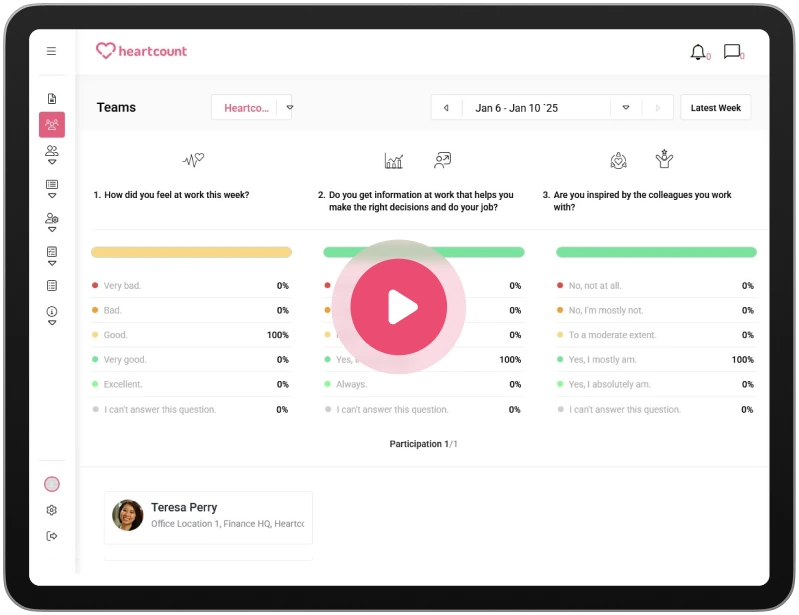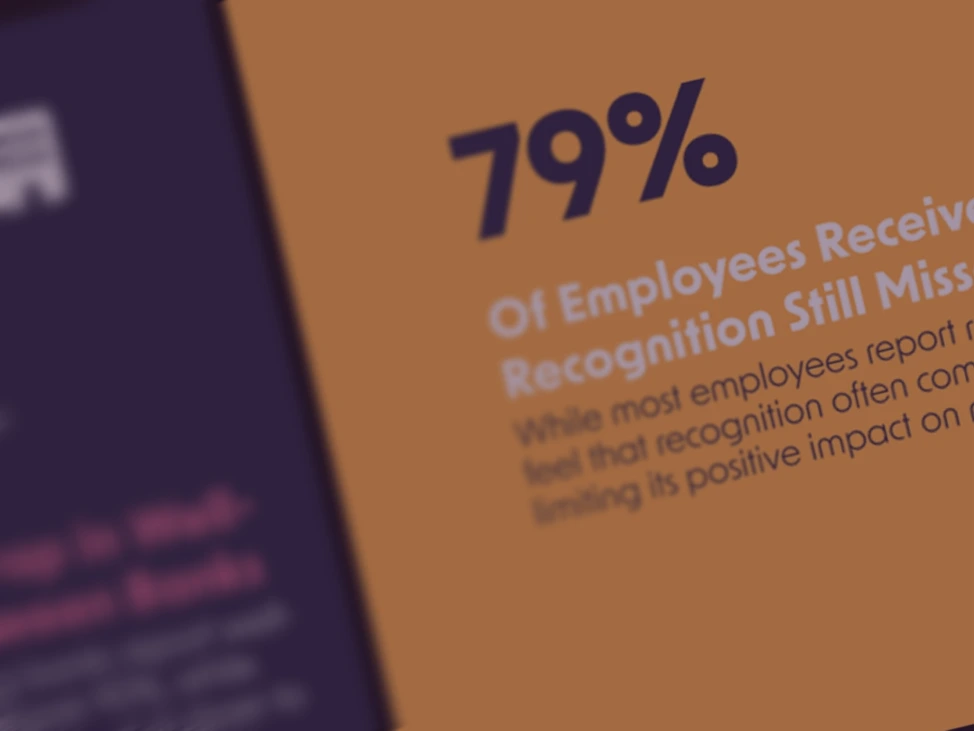Employee Pulse Surveys: How to Create One with a Strong Response Rate

Keeping an eye on how your employees feel about the company, the work they do, and their teams can be challenging—especially in distributed, hybrid, and remote teams.
Many businesses rely on employee pulse checks to help them solve this issue and better understand the employee experience and satisfaction and how these are connected with the company culture and bottom line.
If you associate the term “survey” with a time-consuming and eventually useless form with irrelevant questions, we’re here to show you how to create employee pulse surveys that your team will actually want to respond to.
-
1.What is an employee pulse check?
-
2.What can an employee pulse check reveal about your team?
-
3.The importance of a strong survey response rate
-
4.What questions to include in an employee pulse check?
-
5.How do conduct an employee pulse survey: step by step
-
6.Take the pulse of your team with HeartCount
Keeping an eye on how your employees feel about the company, the work they do, and their teams can be challenging—especially in distributed, hybrid, and remote teams.
Many businesses rely on employee pulse checks to help them solve this issue and better understand the employee experience and satisfaction and how these are connected with the company culture and bottom line.
If you associate the term “survey” with a time-consuming and eventually useless form with irrelevant questions, we’re here to show you how to create employee pulse surveys that your team will actually want to respond to.
What is an employee pulse check?
An employee pulse check is a quick, short, and frequently distributed survey designed to capture the “pulse” of employee sentiments and engagement levels within an organization.
Unlike traditional, lengthy employee surveys that might be conducted annually, pulse surveys are shorter and more focused, often consisting of just a few questions. They can be conducted weekly, monthly, or at any interval that suits the organization’s needs.
Organizations of all sizes and industries use pulse surveys to stay connected with their employees’ needs and concerns. These surveys enable HR departments and management to quickly identify and address issues, track trends in employee sentiment over time, and measure the impact of new policies or initiatives.
The key use of surveys, however, lies in acting on employee feedback. This way, companies can improve employee engagement, retention, and overall workplace culture, affecting their overall productivity and profitability.
What can an employee pulse check reveal about your team?
Employee pulse checks can offer a comprehensive view of the health of your team, uncovering both strengths to build on and areas that require attention. These checks are crucial in creating a responsive, engaging, and supportive workplace where employees can thrive.
Key insights and advantages include:
- Employee engagement and satisfaction: Pulse checks can gauge your team members’ overall engagement and satisfaction levels. Understanding how invested employees are in their work helps identify areas for improvement to boost morale and productivity.
- Trends in employee sentiment: Regular pulse checks allow you to track changes in employee sentiment over time, helping identify trends that may indicate larger issues within the team or organization, such as growing dissatisfaction or disengagement.
- Communication and collaboration: Feedback from pulse checks can indicate how effectively team members communicate and collaborate. Following results, management can intervene and promote better teamwork and problem-solving.
- Immediate feedback on initiatives: When new policies, projects, or changes are implemented, pulse checks can provide immediate feedback on their reception and effectiveness. Management can quickly make adjustments as needed.
- Identify development opportunities: Responses can highlight areas where employees need more support, training, or resources to perform their best. Addressing these needs can lead to a more skilled and confident workforce.
- Well-being and work-life balance: Pulse surveys often reveal how employees feel about their work-life balance and overall well-being. This information can be vital for creating policies that support a healthy balance and reduce burnout.
- Increased trust and transparency: Companies can foster a culture of trust and transparency by regularly collecting and acting on feedback. Employees will feel heard and valued, which can enhance loyalty and commitment.
For example, with HeartCount’s pulse checks, you can easily measure eight categories of employee engagement. This helps you track and understand how employees are motivated and connected and how it impacts their productivity.

The importance of a strong survey response rate
A strong response rate in employee pulse checks ensures that the feedback accurately reflects the whole team’s sentiments, not just a minority. If your pulse check collects insufficient data, you may not be able to draw conclusions from it.
High participation guarantees comprehensive insights, gives credibility to the findings, and allows for more informed decision-making. A high response rate also signals healthy employee engagement and trust in the survey process, as employees are more likely to participate if they believe their feedback will result in real change.
On the other hand, low response rates risk biasing the results and missing key insights, potentially leading to decisions that don’t address the broader team’s needs or concerns.
Ensuring anonymity, simplifying the survey process, and demonstrating that feedback results in meaningful action can help increase response rates.
Some benchmarks show that everything above 70% participation rate is considered good. The rule of thumb is typically “the higher, the better”, although a 100% response rate can often seem suspicious, signaling coercion or unmeaningful responses, just for the sake of participating and “getting it over with.”
What questions to include in an employee pulse check?
The questions you’ll use in your employee pulse check depend on what you’re aiming to measure. For example, you may want to learn how your employees feel about their relationships with their managers, professional development opportunities at work, or how well their values are aligned with what the company stands for.
In general, there are several aspects of employee satisfaction and engagement HR teams typically want to evaluate through surveys:
- Feedback & recognition
- Personal advancement
- Job satisfaction
- Attitude towards the company
- Relationship with management
- Relationship with colleagues
- Productivity & efficiency
To ensure the optimal response rate, make sure the questions are short and simple. Use clear and direct language with no room for misinterpretation. Assure employees their responses will be anonymous and confidential to encourage honest feedback, and offer response options to facilitate participation and capture the full spectrum of employee sentiment.
If you’re not sure how many questions to include in the survey, follow the simple rule of thumb: the more frequent, the shorter. Your employees are less likely to answer 20 questions every week, but replying to three short questions each Friday is a low effort for them and a meaningful reward for you in terms of valuable data.
Before you launch a survey, set a goal and a metric to have more clarity on what questions you should include. If you need inspiration, check out our blog post with 18 employee pulse check question ideas (that we actually use in our product!).
How do conduct an employee pulse survey: step by step
If you’ve never done (enough) employee pulse checks before, you may not know where to start and how to organize this process to ensure efficiency. We’re sharing a step-by-step guide to help you launch your pulse survey with success.
Define survey goals and scope
Determine the goal of your survey and which employees are eligible to participate, as sometimes, not everyone will be able to provide the data you need.
For example, if there’s been a recent restructuring, employees who joined later may not be eligible to participate in a survey that’s supposed to measure how employees feel about change management.
Depending on the survey goal, define its scope so that you can choose the right questions. Focus on key aspects such as communication, recognition, work-life balance, and career development. The survey goal will also inform your decision on survey cadence: whether you want to send it weekly, monthly, quarterly, or annually.
Choose a survey tool or platform
Create a checklist with features or capabilities you’re looking for in a survey tool. Maybe you need it to integrate with HR tools you’re already using, provide an anonymous way to collect employee answers, or offer both predetermined questions and the possibility to add your own.
Once you know what you need from the tool, create a shortlist of the best candidates and schedule demos to see the platforms in action.
For example, if your goal is to reduce employee churn rate and want to recognize early signs of employee disengagement and burnout, you may appreciate HeartCount’s proprietary feature called Individual Retention Predictability (IRP), which allows you to receive a heads up when the survey answers of an employee indicate they might be a flight risk.
Design survey questions
Depending on the tool you’ve chosen, you may already have some template questions available that are suitable for your survey purpose. You can also come up with your own questions and response options, such as scales from 1 to 5, from completely disagree to completely agree, or from always to never.
A few common questions may be the following:
- On a scale of 1 to 5, how satisfied are you with the communication from leadership?
- How often do you receive recognition for your contributions?
- How likely would you recommend our company as a good workplace?
- How motivated do you feel to complete your work tasks?
- Do you have trust in the colleagues you work with?
Use a variety of question types, including multiple-choice, rating scales, and open-ended questions, to gather both quantitative and qualitative feedback. Different types of questions can provide a more comprehensive understanding of employee sentiment.
Once you have all the questions in place, you can create a pilot test with a small group of employees (for example, 5-10) to review the survey questions for clarity and relevance. Gather feedback on question wording and response options.
See also: Why Traditional Satisfaction Surveys Fail
Communicate survey details to your employees
If the employees just receive the survey out of the blue, they’ll be less likely to respond to it as they won’t be sure of its purpose. To ensure a good response rate, let the team know that you’re launching a survey and explain what you’re aiming to achieve with it.
Send an email announcement to all employees explaining the purpose of the survey, its importance, and the timeline for completion. Assure employees of confidentiality and encourage participation, also mentioning they’ll be able to have insight into the survey results and your action plan afterwards.
Administer survey and collect responses
Distribute the survey link via email or internal communication channels with clear instructions on how to access and complete the survey.
Consider sending reminder emails or Slack messages to boost participation rates and remind employees that it’s in their best interest to provide meaningful feedback on the survey topic. Also, encourage employees to ask questions about the survey in case they don’t understand what specific questions measure or how they’re relevant.
Meanwhile, monitor survey responses in real-time using the survey tool’s dashboard. Track participation rates and identify any departments with low response rates for targeted follow-up. Remember, the data around the pulse check can also reveal a lot—if the employees aren’t motivated to participate, it may imply disengagement.
Analyze survey data and share results with the team
Use data analysis tools to analyze survey responses and identify trends, patterns, and areas for improvement. Aggregate quantitative ratings and analyze qualitative feedback for deeper insights, in case you’ve used open-ended questions.
Once you have organized the data and pulled out trends and insights, prepare a presentation or report summarizing key survey findings, insights, and actionable recommendations.
Share the results with senior leadership, HR teams, and managers, and collaborate on developing an action plan to address identified areas for improvement.
Don’t forget to share the results with other participants, too. Send a company-wide email or hold an all-hands meeting to explain your approach to data analysis and reveal the most significant insights. Explain how you’re planning to act on those insights and when employees can expect to see changes or improvements.
This is a great way to lead by example; if you require accountability from your employees, there’s no better way to encourage them to own their work than by holding yourself accountable for acting on pulse check results.
With HeartCoutn’s advanced analytics, you can gain in-depth insights into team dynamics, identify any immediate concerns, and maintain momentum through weekly snapshots into employee engagement.

Read more: 7 Employee Retention Strategies Every Company Should Follow
“We try to guide companies and their organizational culture toward fostering two-way communication. That means they should always share it publicly when there’s a positive change made, thanks to the employee feedback collected through surveys. For example, if you improve the work environment, you should connect that result back to the information provided by your employees.” —Tijana Andjelic, CEO at HeartCount
Take the pulse of your team with HeartCount
HeartCount offers an intuitive employee experience platform that provides you insight into how your employees feel about the workplace, team, managers, and more—in real-time.
The opportunity to act on employee engagement data promptly allows you to reduce employee turnover, build a positive workplace culture of sharing and honest feedback, and make strategic, informed decisions about your team.
Our platform provides a set of features that enable feedback collection, employee pulse checks, giving public recognition to your teammates, measuring employee engagement index, and much more.
Start a free trial to see HeartCount in action.








